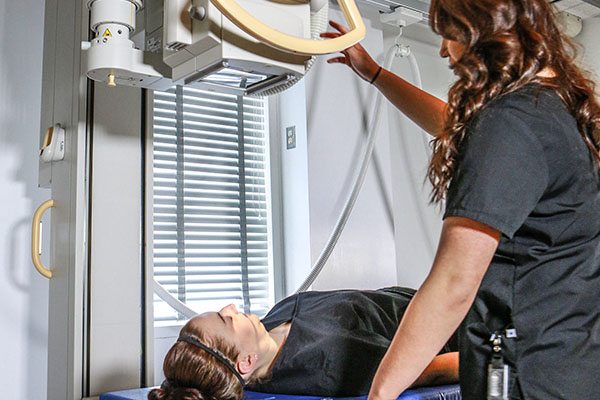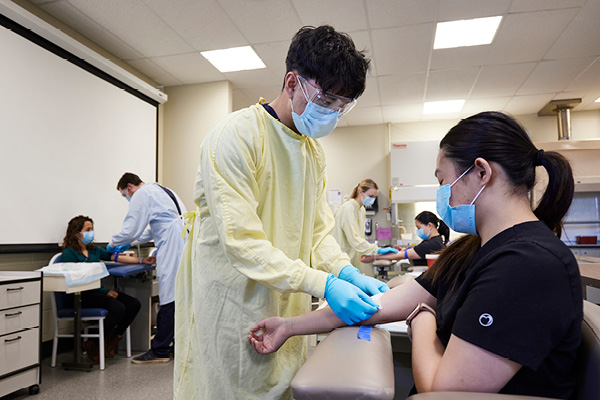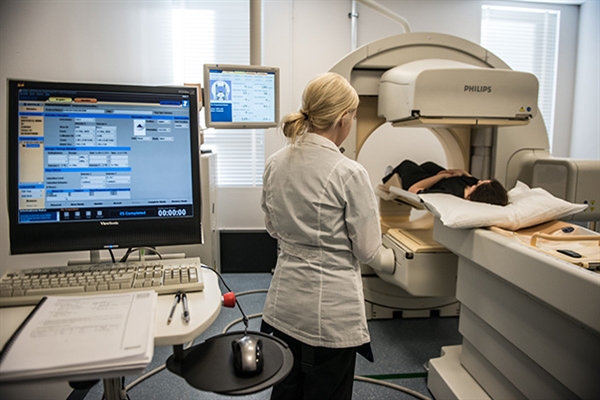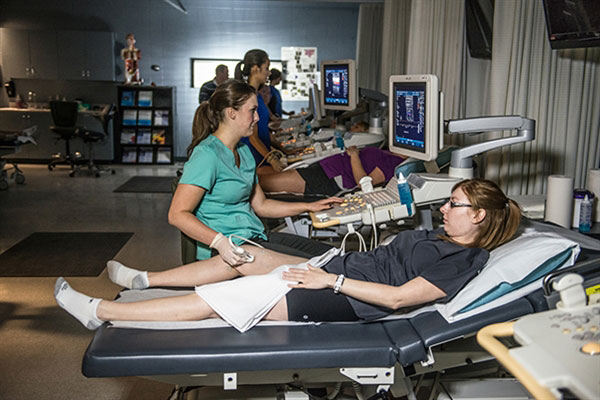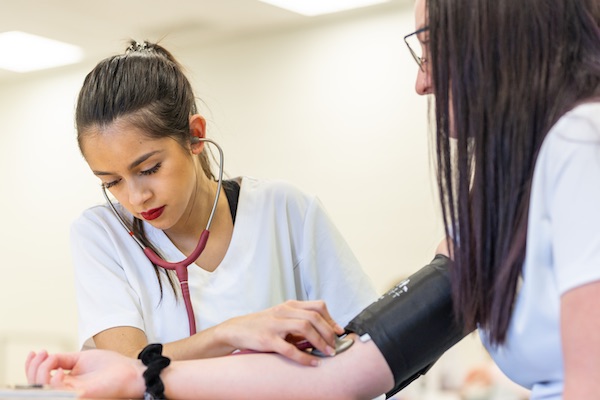On this page:
Mandatory requirements
Applicants for this program are required to complete the School of Health and Public Safety entrance testing process as an admission requirement for this program by the set deadlines. Review admission requirements for more details.
Overview
Our Medical Radiologic Technology program blends art and science, preparing you to become a proficient radiologic technologist.
It integrates classroom knowledge with practical clinical skills and incorporates real-world experience through rotations in three different radiology departments.
In this program, you will:
- learn techniques for correctly positioning patients and X-ray equipment to capture clear diagnostic images
- train on the use and maintenance of various types of X-ray-generating machines
- gain skills in producing digital images to assist physicians in medical diagnoses
- study human anatomy and diseases to understand the physiological basis of the images
- learn management and care of imaging equipment and image production
- receive specific training in CT imaging and the interpretation of CT scans
- gain knowledge of radiation protection for the safety of patients and healthcare workers
- master both general and specialized radiographic procedures
- develop professional conduct and effective patient care practices
- gain insight into specialized imaging processes such as interventional procedures, magnetic resonance imaging (MRI) and ultrasound
- learn the protocols for quality control in radiologic technology.
As a graduate, you’ll be ready for numerous entry-level positions in various healthcare settings, such as hospitals and community clinics.
With experience, you can specialize in general X-ray, interventional radiography, computed tomography, and mammography. There are also potential career paths in management roles or as educators in the radiologic technology field.
If you have a strong interest in medicine, healthcare technology and patient care, this program provides the technical knowledge and clinical skills needed to embark on a rewarding career in medical imaging.
Those in medical radiologic technology tend to be objective, methodical and innovative.
You need:
- a sense of responsibility and integrity
- to tolerant the sight of human blood and tissue
- to be comfortable performing patient care procedures which may be sensitive or performed in close proximity
- an eye for detail and accuracy
- patience and adaptability
- sensitivity to the needs of ill and injured people
- good speaking and writing skills
- the ability to put people at ease
- an interest in science and technology
- a willingness to keep your skills and knowledge up to date
- organizational skills
- problem-solving and critical-thinking skills
- the ability to work well in a team
- the ability to manage your stress well
- the ability to reach a minimum height of 180 cm (to move overhead equipment).
As a medical radiologic technologist, you may work in environments where a considerable amount of time is spent on your feet or you’re performing repetitive tasks. You must observe safety precautions and pay attention to ergonomics to reduce your risk of exposure and injury.
Individuals with previous chronic or repetitive strain injuries have experienced re-injury or aggravation of these conditions in this program and profession. You must also be able to tolerate latex and disinfection chemicals.
You are strongly encouraged to refer to the ALIS website for career, learning, and employment information for medical radiologic technologists to ensure you can successfully meet the occupational requirements for the program and profession.
The opportunity to advance your education by transferring into this program or gain credit for previous postsecondary courses may be available.
There may also be opportunities to further your education once you graduate.
Learn more about program and institution transfer options.
You will complete three clinical practicums in this program.
You will be assigned practicum placements with consideration given to your preference of location. However, due to limited availability in Calgary, it might be necessary for you to travel or relocate outside the city.
Special considerations will not be accommodated. You will be responsible for covering the associated fees of the practicum, including entrance requirements, relocation, and travel costs.
In compliance with the practica agreements with our clinical partners, you will be required to provide specific documentation before you can participate in your practicum. Find out what requirements you need for this program.
Our Medical Radiologic Technology program is accredited by Accreditation Canada. SAIT works closely with our Diagnostic Imaging Advisory Committee to ensure our curriculum continues to meet or exceed provincial and national accreditation standards.
Graduates will be eligible to challenge the Canadian Association of Medical Radiation Technologists (CAMRT) certification exam, a requirement for registration and employment for medical radiologic technologists in Canada. Successful completion of the exam will enable you to work anywhere throughout Canada.
Upon successful completion of this program, you’ll be awarded a SAIT Medical Radiologic Technology diploma.
Careers and opportunities
Each year, SAIT conducts a survey between February and April to determine the employment rate, salary and satisfaction of our newest SAIT alumni.
![]() 100% graduate employment rate
100% graduate employment rate
![]() $67,500 average starting salary
$67,500 average starting salary
Find out more about our graduate employment statistics >
Our graduates may work in the following occupations. Some careers require additional experience and education.
Associated National Occupational Classification (NOC) codes: 32121, 32122, 32124, 32129, 33103.

Career counselling and support
Unsure which career path is for you? SAIT offers career planning services to help you decide your future.
You can also get started by taking our online career finder quiz, which can help you narrow down your search based on your current skills and interests.
Finally, you can also head to Alberta alis for various tools and resources, including additional quizzes and labour market information to help you narrow down a career path.
Services and workshopsCourses
The Medical Radiologic Technology diploma requires 63 credits (24 courses) to complete.
The program spans two years, with three semesters each year.
| Course | Credits |
|---|---|
|
Anatomy and Pathology 1 focuses on select clinical and anatomic presentations of human health and disease states from the standpoint of the radiologic technologist. Conventional anatomic presentations and images from a variety of medical diagnostic modalities related to the central nervous, endocrine, immune, and cardiovascular systems and hemopoietic sub-system, will be used to demonstrate how structural and functional changes affect radiographic appearances, procedures and protocols. Corequsites:
|
3 |
|
Anatomy and Pathology 2 is a continuation of the course material studied in Anatomy and Pathology 1. Conventional anatomic presentations and images from a variety of medical diagnostic modalities related to the respiratory, gastrointestinal, hepatobiliary, skeletal, and genitourinary systems will be used to demonstrate how structural and functional changes affect radiographic appearances, procedures and protocols. Pre-requisites:
Corequsites:
|
3 |
|
Apparatus and Imaging Management presents the principles of X-ray image formation and manipulation. An explanation of how radiographic equipment works and the ways in which the results can be manipulated in order to obtain the best diagnostic image are discussed. Application of theory and hands-on work with X-rays will help encourage the critical thinking skills required to control image quality as well as safely operate the imaging equipment. Corequsites:
|
3 |
|
The chain of infection and methods of prevention and control of microorganisms, including blood borne viruses such as hepatitis and human immunodeficiency virus (HIV) will be reviewed. Immunization, routine practice, additional isolation precautions, sterilization and disinfection, safety and Workplace Hazardous Materials Information System (WHMIS) are also covered. |
1.5 |
|
This self-directed introductory course enables the learner to use and understand the medical terminology common to most allied health personnel. By learning prefixes, suffixes, and word roots, the learner will be able to build, use, and spell medical words that relate to body systems and body organization. Common abbreviations and symbols are also included. |
1.5 |
|
Patient Care 2 prepares learners for working with isolation patients in a safe and respectful manner. Focus will be placed upon how radiographers addresses medical emergencies. Pharmaceuticals will be explored related to the systems of the body and the medications’ purposes. The principles of vital signs will also be taught and the patient care labs will allow learners with the opportunity to apply their knowledge in a lab environment. Pre-requisites:
|
1.5 |
|
Radiographic Technique 1 presents an introduction to the positioning of patients for radiographic imaging. Through a blend of theory and hands-on experience, importance will be placed upon correct standards of positioning, the positioning nomenclature and how to develop a workflow. The hands-on component includes performing and critiquing radiographic exposures, identifying radiographic anatomy and developing the cognitive and affective skills to correct mistakes and problem solve. Corequsites:
|
3 |
|
Professional Practice 1 is a general introduction to the field of Medical Radiation Technology. Learners will cover a variety of topic areas including the technologist in the workplace, legal issues and relevant professional organizations. There will also be discussions on risk management, professional conduct, with an emphasis on the importance of customer service, conflict management, and problem-solving. Pre-requisites:
Corequsites:MRAD 285 |
1.5 |
|
Patient Care 1 introduces the principles, concepts and applications of proper body mechanics and patient transfers. Documentation, policies, procedures and their importance will be emphasized. The purposes and uses of other types of medical accessory equipment will also be covered. Corequsites:
|
1.5 |
|
In Specialized Imaging 1 the essentials of applying medical and surgical asepsis in healthcare settings are covered. Learners will participate in preparing for, and assisting with, sterile procedures and will practice contact and behaviour required in these unique environments. Diagnostic equipment, its’ capabilities, and adaptions to procedures for special demographic groups will also be covered. Pre-requisites:
Corequsites:ANPH 252 |
1.5 |
|
Computed Tomography Theory 1 provides learners with an overview of computed tomography (CT), basic principles of CT, equipment, image acquisition, reconstruction and quality control. Emphasis will be placed on safety, patient care, assessment and contrast administration. Pre-requisites:One of:
|
3 |
|
Fluoroscopic Imaging introduces how fluoroscopic equipment works and its’ numerous features. Different procedures used to determine the function capabilities and anatomical structures for the digestive, biliary and genitourinary systems will be introduced. Patient care, radiation dose and patient positioning related to these procedures will also be covered. Pre-requisites:
Corequsites:ANPH 252 |
1.5 |
|
Radiographic Technique 2 expands on Radiographic Technique 1 and covers radiographic procedures for more complex anatomical structures, including the vertebrae, thorax, cranium and facial bones. Standard radiographic positioning, exposures and procedures will be discussed, in addition to nomenclature and how to develop a workflow. A hands-on component will allow learners to practice critiquing radiographic images, correcting mistakes and using problem solving skills in the clinical environment. Pre-requisites:
Corequsites:ANPH 252 |
3 |
|
Computed Tomography Theory 2 covers routine computed tomography (CT) procedures and protocols along with the cross-sectional anatomy of the abdomen, chest, head, neck, pelvis, spine and extremities. In addition, focus will be placed on identifying anatomical structures on various cross-sectional imaging planes. Pre-requisites:MRAD 251 |
1.5 |
|
This course introduces adaptive radiology, the process of modifying procedures, and patient care skills to meet specific situations. Assessing and managing patients using effective communication and problem-solving strategies will be performed in a lab setting. Focus will also be placed upon critical thinking, teamwork, conflict management, and decision-making skills in the workplace. Pre-requisites:
Corequsites:MRAD 209 |
1.5 |
|
Specialized Imaging 2 presents specialized examinations, equipment and related procedures used for imaging various body systems. Focus will be placed on bone density, mammography, angiography, radiation protection and patient care. Adjunct diagnostic imaging modalities will also be covered. Pre-requisites:
Corequsites:PRCT 353 |
3 |
|
Clinical Integration 1 reviews medical radiographic technology concepts covered to-date and provides learners with opportunities to integrate their experiences in the clinical environment with theoretical concepts. Preparation for the national CAMRT exam will also be covered. Pre-requisites:
Corequsites:PRCT 356 |
1.5 |
|
Clinical Integration 2 builds upon Clinical Integration 1 with more technologically-advanced concepts related to medical radiologic technology imaging being presented. Opportunities are provided for the learner to integrate theoretical concepts in a clinical environment. Preparation for the national Canadian Association of Medical Radiologic Technologists (CAMRT) exam will also be covered. Pre-requisites:
Corequsites:PRCT 358 |
1.5 |
|
This course reviews elements of the research process. Topics include forming a research question, designing research strategies, and analyzing research data. Pre-requisites:One of:
|
1.5 |
|
Clinical Practicum 1 involves performing procedures under the supervision of registered technologists in a clinical environment. Aspects of clinical work covered include practice in patient care and handling, radiographic positioning, equipment use, radiation protection and image evaluation. Pre-requisites:
Corequsites:MRAD 302 |
6 |
|
Clinical Practicum 2 provides learners with an opportunity to perform patient care and handling, radiographic positioning, equipment use, and radiation protection in a radiology department. Emphasis is placed on mastering image evaluation, typical positioning and more advanced procedures. Pre-requisites:
Corequsites:
|
6 |
|
Clinical Practicum 3 builds on the previous practical and involves clinical education under the supervision of registered technologists. Focus will be on continued practice in patient care and handling, radiographic positioning, equipment use, radiation protection, quality control and image evaluation. Mastering advanced procedures will also be emphasized. Pre-requisites:
Corequsites:
|
6 |
|
Quality Assurance & Control provides an introduction to quality control tests for radiographic equipment and the development and maintenance of a quality assurance program. The values of resource management and quality assurance in the diagnostic imaging department will also be discussed. Pre-requisites:
Corequsites:PRCT 356 |
3 |
|
Radiation Protection introduces radiographic policies, regulations and procedures that are based on the as-low-as-reasonably-achievable (ALARA) principle for the protection of self, the patient and the other individuals who may find themselves exposed to medical radiation. Topics will also include the effects of ionizing radiation on body tissues and the detection and measurement of radiation. Corequsites:
|
3 |
Progression
Students must attain a PGPA and/or a CGPA of 2.0 or better in each semester and pass the necessary prerequisite courses to progress through the program. To qualify for graduation, students must pass all courses, attain a CGPA of 2.0 or better and complete course requirements within the prescribed timelines.
Admission requirements
Applicants educated in Canada
Applicants must demonstrate English language proficiency and meet the following requirements or equivalents.
At least 75% in the following courses or equivalents:
- Math 30-1, or Math 30-2, AND,
- English Language Arts 30-1, AND,
- Physics 30, AND,
- One of either Biology 30, Chemistry 30, or Science 30
AND
- a mark of at least 50% in the School of Health and Public Safety’s Entrance testing process.
SAIT accepts high school course equivalents for admission for applicants educated outside Alberta.
All applicants who were educated outside of Canada must demonstrate English Language proficiency and provide proof they meet the program admission requirements with an international document assessment. Find out what educational documents are accepted and assessment options.
SAIT may also accept courses completed at certain international post-secondary institutions.

Academic Upgrading
Missing an admission requirement for this program? Upgrade your prior education to help you receive admission into one of SAIT's career programs.
Upgrade
English language proficiency
All applicants must demonstrate English language proficiency prior to admission, including students educated in Canada.
Learn moreAvailable intakes
Fall 2024
Start dates:
- Domestic students: Closed
-
-
Application deadline: Jan. 31, 2024
-
Costs
2024/25 tuition and fees
The following costs are effective as of July 1, 2023.
The suggested schedule of study for this program has been modified for students beginning the program in the 2024/25 academic year. If you are a continuing student, your tuition and fees may be different for years 2 and 3. Please contact the School of Health and Public Safety for more information.
Domestic students
*.5 indicates a combination of full-time semester(s) and part-time semester(s) in the same academic year. In many cases, students are completing a practicum during their part-time semester. Part-time students are those taking less than nine (9) course credits in a semester.
**Based on six months of health and dental benefits only.
Books and supplies are approximately $2,500 in the first year and $700 in the second year.
This is a bring-your-own-device program with a standard computer hardware and software requirement. See the specific requirements on our computers and laptops page.
Find your booklist on the SAIT Bookstore's website. The booklist will be available closer to the program start date. Can’t find your program or course? The bookstore didn't receive a textbook list. Contact your program directly to determine if they’re still refining course details or if you're in luck; no textbook purchase is required this term.
Students are responsible for any additional expenses related to their practicum, including pre-practicum requirements outlined by the program and relocation costs to practicum sites outside of Calgary.
Tech requirements
You will be evaluated on your competency performance level using a tracking system called CompTracker. You will require a wifi-enabled Apple tablet that can run the most up-to-date operating system to support the CompTracker system.
- Any size tablet is acceptable.
- Keyboards are advisable but not mandatory.
- Smartphones are not acceptable devices for CompTracker.
There is a required user license fee billed on a per-semester basis. Each program will have a different student fee depending on how the system is used within the program. More information will be shared at orientation.
Required personal protective equipment (PPE)
The industry-approved PPE you'll need will be discussed during your first few days of classes.
For your first day of labs, your required uniform should include the following:
- Plain black scrub-style pants and top (coloured piping accents are acceptable)
- Closed-toe and heel footwear in plain white or black (no logos or stripes of colour), runners, or duty shoes.
- Short black/white lab coat (optional)
Additional fees
- Canadian Association of Medical Radiation Technologists (CAMRT) certification exam fees are approximately $840, with an additional exam registration fee.
- Annual dues to the Alberta College of Medical Diagnostic and Therapeutic Technologists are approximately $100.
- CPRS 001 BLS Provider (Level C) CPR annual updates are required. All CPR courses must be from the Heart and Stroke Foundation.
- A fee is associated with obtaining a police information check, including a Vulnerable Sector Check, payable to the Police or the Royal Canadian Mounted Police (RCMP).
- Students must have their immunizations reviewed by the SAIT Health Clinic. There is a $75 charge to review vaccine history. Any vaccines to be administered will result in additional charges.
- A fee of approximately $50-$100 is associated with an Electronic Student Permit Checking submission, which is required for clinical practicum placements, payable to Synergy Gateway through the Verified software platform.
2023/24 tuition and fees
The following costs are effective as of July 1, 2023.
Domestic students
*.5 indicates a combination of full-time semester(s) and part-time semester(s) in the same academic year. In many cases, students are completing a practicum during their part-time semester. Part-time students are those taking less than nine (9) course credits in a semester.

Financial aid
Paying for your education may feel overwhelming, but we have resources and programs that can help, including information about payment options, student loans, grants and scholarships.
Learn moreApplication process
Applicants must meet or exceed a score of 50% in the School of Health and Public Safety entrance testing process as an admission requirement for this program by the set deadlines.
These deadlines may be different than the typical application closing dates.
Learn more about the entrance testing process >
Ready to apply?
Follow our step-by-step guide to submitting a successful application.
Communication during admission
Email is the primary source of communication during the admission process. Ensure your personal email account is managed appropriately to receive our emails, files and communications.
We recommend you add hps.info@sait.ca domain to your safe senders' list or you risk missing critical email messages.

Begin your application
Apply now using the online application portal.
Ensure you have a valid Visa or Mastercard to pay the non-refundable application fee of $120 for domestic applicants or $150 for international applicants.
Apply nowInformation sessions
Prepare for a strong start in your chosen program or get the details you need to decide your future path.
Our expert staff and faculty are ready to answer your questions and provide information about the following:
- What sets SAIT apart
- An introduction to the program and area of study
- Admission requirements
- Future career paths
- Information on the earning potential and graduate employment rates.
Contact us
School of Health and Public Safety Advising
-
Phone - 403.284.8500
-
Email - hps.info@sait.ca
Subscribe for updates
Your journey starts here! Sign up to get important updates on:
- Health and medical programs
- Application information
- Relevant news and events
